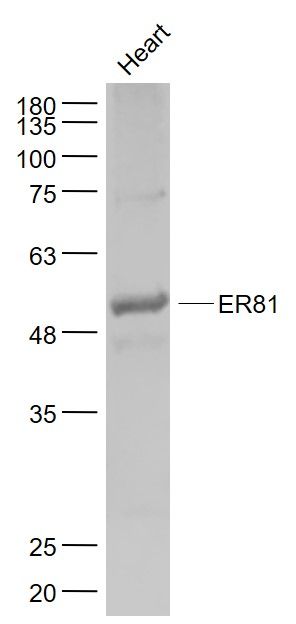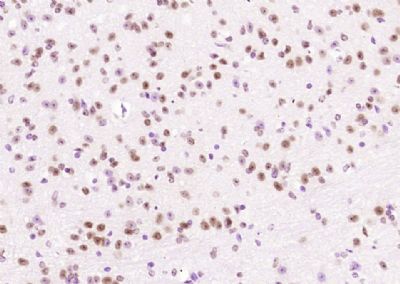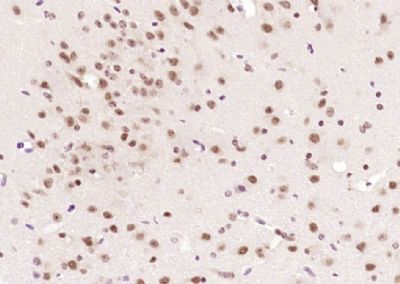Several members of the Ets gene family encode sequence-specific DNA binding proteins that recognize DNA sequences with a centrally located 5'-GGAA-3' element. All of the Ets proteins recognize the same central core sequence but each protein interacts with unique sequences that flank this core. PEA3 binds the motif 5'-AGGAAG-3', while ER81 (also designated ETV1) binds the motif 5'-CGGAA/T-3'. PEA3 is expressed at readily detectable levels in cells of epithelial and fibroblastic origin. Unlike other members of the Ets family, including Ets-1 and Ets-2, PEA3 is not expressed in hematopoietic cells. ER81 is highly expressed in brain, testis, lung and heart. ER81 is also moderately expressed in spleen, pancreas, colon and small intestine. During development, ER81, PEA3 and ERM display unique expression patterns which suggest these transcriptional factors play an important role in organogenesis. ERK-1 activates ER81 transcriptional activity, while MAPKAP kinase 2 inhibits ER81.
Function:
Transcriptional activator that binds to DNA sequences containing the consensus pentanucleotide 5'-CGGA[AT]-3'.
Subcellular Location:
Nucleus.
Tissue Specificity:
Very highly expressed in brain, highly expressed in testis, lung and heart, moderately in spleen, small intestine, pancreas and colon, weakly in liver, prostate and thymus, very weakly in skeletal muscle, kidney and ovary and not in placenta and peripheral blood leukocytes.
Post-translational modifications:
Sumoylated.
DISEASE:
Defects in ETV1 are a cause of Ewing sarcoma (ES) [MIM:612219]. A highly malignant, metastatic, primitive small round cell tumor of bone and soft tissue that affects children and adolescents. It belongs to the Ewing sarcoma family of tumors, a group of morphologically heterogeneous neoplasms that share the same cytogenetic features. They are considered neural tumors derived from cells of the neural crest. Ewing sarcoma represents the less differentiated form of the tumors. Note=A chromosomal aberration involving ETV1 is found in patients with Erwing sarcoma. Translocation t(7;22)(p22;q12) with EWSR1.
Similarity:
Belongs to the ETS family.
Contains 1 ETS DNA-binding domain.
SWISS:
P50549
Gene ID:
2115
Database links:
Entrez Gene: 395748 Chicken
Entrez Gene: 540846 Cow
Entrez Gene: 475246 Dog
Entrez Gene: 2115 Human
Entrez Gene: 14009 Mouse
Entrez Gene: 362733 Rat
Omim: 600541 Human
SwissProt: Q2KIC2 Cow
SwissProt: P50549 Human
SwissProt: P41164 Mouse
Unigene: 22634 Human
Unigene: 4866 Mouse
| Picture |
Sample:
Heart (Mouse) Lysate at 40 ug
Primary: Anti- ER81 (SL10949R) at 1/1000 dilution
Secondary: IRDye800CW Goat Anti-Rabbit IgG at 1/20000 dilution
Predicted band size: 55 kD
Observed band size: 55 kD
Paraformaldehyde-fixed, paraffin embedded (mouse cerebellum); Antigen retrieval by boiling in sodium citrate buffer (pH6.0) for 15min; Block endogenous peroxidase by 3% hydrogen peroxide for 20 minutes; Blocking buffer (normal goat serum) at 37°C for 30min; Antibody incubation with (ER81) Polyclonal Antibody, Unconjugated (SL10949R) at 1:200 overnight at 4°C, followed by operating according to SP Kit(Rabbit) (sp-0023) instructionsand DAB staining.
Paraformaldehyde-fixed, paraffin embedded (mouse brain); Antigen retrieval by boiling in sodium citrate buffer (pH6.0) for 15min; Block endogenous peroxidase by 3% hydrogen peroxide for 20 minutes; Blocking buffer (normal goat serum) at 37°C for 30min; Antibody incubation with (ER81) Polyclonal Antibody, Unconjugated (SL10949R) at 1:200 overnight at 4°C, followed by operating according to SP Kit(Rabbit) (sp-0023) instructionsand DAB staining.
|
|
|


